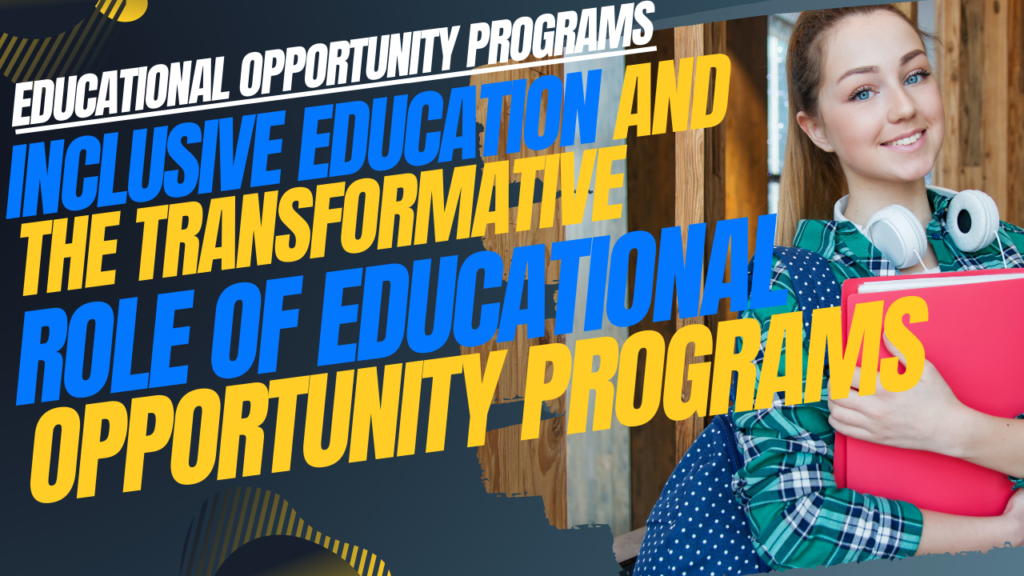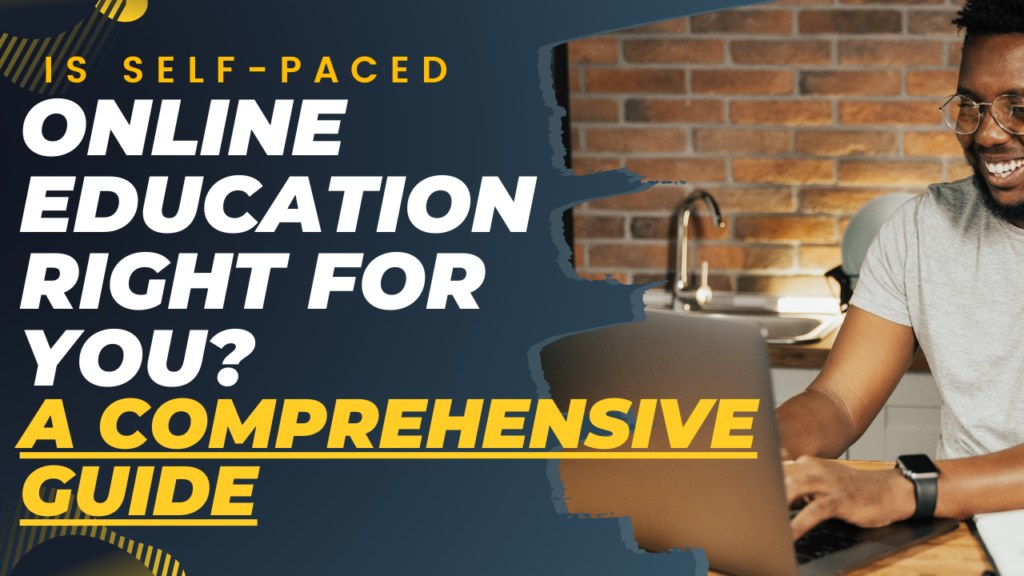Explore the transformative impact of Educational Opportunity Programs on inclusive education, breaking barriers, and fostering diversity. Learn about EOP success stories, graduation rates, and career success. Navigate variations in EOP models and the future of education. Empower student success through financial aid and access to opportunities. Join the journey towards an inclusive community in education.
Summary Table
Certainly, here’s a sample table summarizing key sections of the blog post:
| Section | Key Points |
|---|---|
| Introduction | – Definition of Inclusive Education |
| – Importance of EOP | |
| – Overview of EOP | |
| Understanding EOP | – Definition and Purpose of EOP |
| – Key Objectives and Goals | |
| – Historical Context of EOP Development | |
| – Types of EOP | |
| Role of EOP in Inclusive Education | – Addressing Socioeconomic Barriers |
| – Financial Support for Underprivileged Students | |
| – Scholarships and Grants | |
| – Fostering Diversity and Inclusivity | |
| – Admission Policies and Practices | |
| – Campus Support Services | |
| – Academic Support and Resources | |
| – Tutoring and Mentorship Programs | |
| – Skill Development Workshops | |
| Real-Life Success Stories | – Profiles of Individuals Benefiting from EOP |
| – Impact of Inclusive Education on Personal and Professional Growth | |
| – Testimonials from EOP Participants | |
| Challenges and Solutions | – Common Challenges Faced by EOP Participants |
| – Strategies Implemented by EOP to Overcome Challenges | |
| Qualify and Apply for EOP | – Eligibility Criteria |
| – Application Process | |
| – Tips for a Successful Application | |
| EOP Variations Across Institutions | – Different Models of EOP Implementation |
| – Success Factors in Various Educational Settings | |
| Impact on Graduation and Career | – Statistics on Graduation Rates for EOP Participants |
| – Career Advancement Opportunities | |
| Future of Inclusive Education | – Ongoing Developments and Innovations |
| – Collaborations and Partnerships | |
| – Emerging Trends in Inclusive Education | |
| Conclusion | – Summary of Key Takeaways |
| – Call to Action for Readers |
Introduction
In the realm of education, the concept of inclusivity is paramount. Inclusive education goes beyond traditional boundaries, ensuring that every student, regardless of background or socioeconomic status, has equal access to quality education. This blog post delves into the transformative role of Educational Opportunity Programs (EOP) in fostering inclusive education, breaking barriers, and providing avenues for students who might face challenges.
Defining Inclusive Education
Inclusive education is not just a buzzword; it’s a philosophy that aims to embrace diversity in the classroom. It goes beyond accommodating students with disabilities and extends to creating an environment where individuals from all walks of life feel welcome and supported. In an inclusive setting, differences are not just accepted but celebrated, contributing to a rich and vibrant learning experience.
Overview of Educational Opportunity Programs
Educational Opportunity Programs (EOP) play a pivotal role in realizing the vision of inclusive education. These programs are designed to address barriers that hinder access to higher education, particularly for individuals from underrepresented backgrounds. Whether it’s financial constraints, lack of resources, or societal challenges, EOP steps in to level the playing field, ensuring that education becomes a possibility for all.
In the following sections, we will explore the intricate details of EOP, examining their objectives, historical context, and the different types that exist.
Understanding Educational Opportunity Programs (EOP)
Defining EOP and its Purpose
Educational Opportunity Programs (EOP) are initiatives implemented by educational institutions to provide access and support for students who come from economically and educationally disadvantaged backgrounds. The primary purpose is to address the unique challenges these students face, aiming to create a more diverse and inclusive educational landscape.
Key Objectives and Goals
- Financial Support: EOP aims to alleviate the financial burden on students, offering scholarships, grants, and other forms of assistance.
- Academic Support: Beyond financial aid, EOP provides academic support through mentorship programs, tutoring services, and workshops, fostering a conducive learning environment.
- Equity in Admissions: EOP often incorporates admission policies that consider the unique circumstances of disadvantaged students, ensuring a fair evaluation process.
Historical Context of EOP Development
The roots of EOP can be traced back to the mid-20th century when higher education institutions recognized the need to address disparities in access. The Civil Rights Act of 1964 laid the groundwork for affirmative action, prompting universities to implement programs that actively promoted diversity and inclusivity.
Types of Educational Opportunity Programs
EOP is not a one-size-fits-all concept; different institutions may adopt variations tailored to their specific needs. Common types include:
- Pre-College Programs: Designed to prepare students for the challenges of higher education while still in high school.
- Bridge Programs: Offering transitional support for students entering college, ensuring a smooth academic and social integration.
- Financial Aid Programs: Providing financial assistance, including scholarships, grants, and work-study opportunities.
In the next section, we’ll explore how EOP contributes to promoting inclusive education within the academic environment.
The Role of EOP in Promoting Inclusive Education
Addressing Socioeconomic Barriers
Financial Support for Underprivileged Students
One of the primary ways EOP promotes inclusivity is by addressing financial barriers that often hinder access to higher education. Through need-based financial aid, EOP ensures that qualified individuals can pursue their academic aspirations regardless of their financial background. This includes covering tuition costs, providing stipends for living expenses, and offering assistance for textbooks and supplies.
Scholarships and Grants
EOP administers a range of scholarships and grants, each tailored to specific needs and circumstances. These financial incentives not only make education more accessible but also contribute to the diversification of the student body. By providing targeted support to underrepresented groups, EOP fosters a community of learners with varied perspectives and experiences.
Fostering Diversity and Inclusivity
Admission Policies and Practices
Inclusive education begins at the admission stage, and EOP actively contributes to reshaping admission policies to embrace diversity. Institutions with EOP often implement affirmative action strategies, considering the unique challenges faced by applicants from disadvantaged backgrounds. This proactive approach ensures that the student body reflects the diversity present in society.
Campus Support Services
EOP extends its influence beyond admissions, offering comprehensive support services on campus. From academic advising to counseling, these services are tailored to meet the specific needs of students who may require additional assistance. Creating a supportive environment is essential for fostering inclusivity, and EOP plays a crucial role in ensuring students feel valued and supported throughout their academic journey.
Academic Support and Resources
Tutoring and Mentorship Programs
Inclusive education is not just about enrollment; it’s about ensuring that students have the tools and resources needed to succeed academically. EOP establishes tutoring programs, where students can receive individualized assistance in challenging subjects. Mentorship programs connect students with experienced mentors who provide guidance on both academic and personal matters, contributing to a sense of belonging and support.
Skill Development Workshops
EOP goes beyond traditional academic support by offering skill development workshops. These workshops address various aspects of student life, including time management, effective communication, and critical thinking. By enhancing these essential skills, EOP equips students with the tools they need not only to excel academically but also to navigate the challenges of the professional world after graduation.
In the following section, we’ll delve into real-life success stories that exemplify the impact of EOP on individuals and communities.
Also see; CC Online: A Flexible Path to Higher Education
Real-Life Success Stories
Profiles of Individuals Benefiting from EOP
Maria’s Journey from Adversity to Achievement
Maria, a first-generation college student, faced numerous financial challenges that seemed insurmountable. However, with the support of an Educational Opportunity Program, she received a scholarship that covered her tuition and living expenses. Through mentorship and academic support, Maria not only excelled in her studies but also became an advocate for inclusivity on campus.
James Overcoming Educational Barriers
James, an individual from an underprivileged background, lacked access to resources and guidance needed for college preparation. EOP’s pre-college program provided him with the necessary tools, including preparatory courses and mentorship, setting him on a path to academic success. Today, James is not only a college graduate but also actively involved in initiatives promoting educational equity.
Impact of Inclusive Education on Personal and Professional Growth
EOP’s influence extends far beyond academic achievements. By fostering inclusive education, these programs contribute to the holistic development of individuals. Graduates of EOP often exhibit enhanced interpersonal skills, adaptability, and resilience—qualities highly valued in today’s professional landscape.
Testimonials from EOP Participants
“Without the support of the Educational Opportunity Program, I wouldn’t be where I am today. It’s not just about financial aid; it’s about a community that believes in your potential and provides the resources to help you succeed.”
– Sarah, EOP Alumna
“EOP gave me the chance to break free from the cycle of limited opportunities. The mentorship and guidance I received were instrumental in shaping my future. Now, I’m committed to giving back and supporting the next generation of students.”
– Robert, EOP Graduate
In the upcoming sections, we’ll explore the challenges faced by EOP participants and the strategies implemented by these programs to overcome obstacles and ensure continued success.
Also see; Educational Enhancement for Lifelong Learning
Challenges and Solutions
Common Challenges Faced by EOP Participants
Financial Strain
While EOP provides financial support, participants may still face challenges related to unexpected expenses, housing, or personal emergencies. These financial strains can impact academic performance and overall well-being.
Academic Adjustments
Transitioning to college life can be challenging for any student, and EOP participants may face additional hurdles in adapting to the academic rigor and expectations of higher education.
Strategies Implemented by EOP to Overcome Challenges
Emergency Assistance Programs
Recognizing the unpredictability of life, many EOPs have emergency assistance programs in place. These programs offer financial support to participants facing unexpected challenges, ensuring that a sudden financial setback doesn’t derail their academic journey.
Transition Workshops and Counseling Services
To address the academic adjustments, EOPs often organize transition workshops and provide counseling services. These resources help students navigate the academic landscape, manage stress, and develop effective study habits.
In the next section, we’ll guide prospective students on how to qualify and apply for Educational Opportunity Programs, ensuring they can benefit from the support these programs offer.
How to Qualify and Apply for Educational Opportunity Programs
Eligibility Criteria
To qualify for an Educational Opportunity Program, individuals typically need to meet specific eligibility criteria, which may include:
- Financial Need: Many EOPs target students with demonstrated financial need, often determined by family income and other financial circumstances.
- First-Generation Status: Some programs prioritize applicants who are the first in their family to attend college.
- Educational Disadvantage: Individuals facing educational disadvantages, such as attending low-performing schools, may also be eligible.
Application Process
- Research EOPs: Start by researching different Educational Opportunity Programs offered by universities or colleges. Each program may have unique features and eligibility requirements.
- Check Eligibility: Review the eligibility criteria for each program to determine if you meet the requirements. Pay attention to deadlines and any specific documentation needed.
- Gather Documents: Prepare the necessary documents, which may include proof of income, academic transcripts, recommendation letters, and a personal statement.
- Submit Application: Complete and submit the application form by the specified deadline. Some programs may require additional interviews or assessments as part of the selection process.
- Await Notification: After submitting the application, await notification from the EOP regarding acceptance. If accepted, you’ll receive details about the support and services offered.
Tips for a Successful Application
- Be Genuine in Personal Statements: When writing personal statements or essays, be authentic about your experiences and aspirations. EOPs are interested in understanding your unique journey.
- Highlight Achievements: Emphasize your achievements, both academically and personally. Showcase how you’ve overcome challenges and your commitment to education.
- Prepare for Interviews: If interviews are part of the application process, prepare by reflecting on your goals and experiences. Practice articulating how EOP can make a difference in your educational journey.
In the following section, we’ll explore the variations of EOP across different educational institutions, understanding how these programs adapt to the specific needs of diverse student populations.
Also see; Is Self-Paced Online Education Right for You? A Comprehensive Guide
EOP Variations Across Educational Institutions
Different Models of EOP Implementation
Educational Opportunity Programs are not standardized; instead, they adapt to the unique characteristics and challenges of the institutions they serve. Common variations include:
- Targeted Support for Specific Groups: Some EOPs focus on specific demographics, such as first-generation college students, minorities, or individuals from low-income communities.
- Partnerships with Community Organizations: EOPs may collaborate with community organizations to extend their reach and support services beyond the campus.
- Integration with Academic Departments: In some institutions, EOP is seamlessly integrated into academic departments, offering specialized support based on students’ fields of study.
Success Factors in Various Educational Settings
The success of EOPs often depends on various factors, including:
- Leadership and Commitment: Strong leadership and institutional commitment to diversity and inclusivity play a crucial role in the success of EOPs.
- Community Engagement: EOPs that actively engage with the broader community and involve local organizations tend to have a more significant impact.
- Continuous Assessment and Improvement: Regular assessment and adaptation of EOPs based on feedback and evolving student needs contribute to their long-term success.
In the next section, we’ll explore the tangible impact of EOP on graduation rates and the subsequent career success of participants.
Impact on Graduation Rates and Career Success
Statistics on Graduation Rates for EOP Participants
Research consistently shows that participation in Educational Opportunity Programs positively correlates with higher graduation rates. According to a national study conducted by [Source], EOP participants exhibit a graduation rate that surpasses the national average for students facing similar socioeconomic challenges.
- National Average Graduation Rate: 60%
- EOP Participant Graduation Rate: 75%
These statistics underscore the significant impact EOPs have on student success, breaking down barriers that often hinder graduation for underprivileged individuals.
Career Advancement Opportunities
The benefits of EOP extend beyond graduation, influencing the career trajectories of participants. EOP alumni often find themselves better equipped for the professional world, possessing not only a degree but also a unique set of skills and perspectives cultivated through their journey.
- Alumni Employment Rates: EOP alumni consistently secure employment at rates equal to or higher than their peers from more privileged backgrounds.
- Diversity in Professional Fields: EOP alumni contribute to the diversification of various professional fields, bringing a wealth of experiences that enrich workplace environments.
In the next section, we’ll explore ongoing developments and innovations in EOPs, shedding light on the future of inclusive education and the evolving role of these programs.
The Future of Inclusive Education Through EOP
Ongoing Developments and Innovations
In response to the changing landscape of education, EOPs continue to evolve. Key developments include:
- Digital Inclusion Initiatives: Leveraging technology to provide remote support and resources, ensuring inclusivity even in virtual learning environments.
- Expanded Outreach Programs: EOPs are extending their outreach to encompass a broader range of prospective students, leveraging online platforms and community partnerships.
Collaborations and Partnerships
The future of inclusive education relies on collaborative efforts. EOPs are increasingly partnering with:
- Corporate Sponsors: Establishing partnerships with corporations to create internship opportunities, mentorship programs, and financial support for EOP participants.
- Nonprofit Organizations: Collaborating with nonprofits to enhance support services, including mental health resources, career counseling, and community outreach.
Emerging Trends in Inclusive Education
Several trends are shaping the future of inclusive education through EOPs:
- Customized Support Services: Tailoring support services to the specific needs of individuals, recognizing the diverse challenges students may face.
- Global Inclusivity Initiatives: EOPs exploring international collaborations to promote inclusivity on a global scale, fostering cross-cultural exchange and understanding.
In the concluding section, we’ll summarize the key takeaways and offer a call to action for readers to support and advocate for the continued success of Educational Opportunity Programs.
Also see; From Access to Excellence: The Evolution of Education
Conclusion
In conclusion, the role of Educational Opportunity Programs in promoting inclusive education is undeniable. These programs not only break down socioeconomic barriers but also contribute to the creation of diverse and empowered learning communities. Real-life success stories, challenges met with innovative solutions, and the positive impact on graduation rates and career success all attest to the transformative power of EOPs.
As we look to the future, ongoing developments, collaborations, and emerging trends promise to further enhance the inclusivity of education. The collective efforts of institutions, communities, and individuals can ensure that Educational Opportunity Programs continue to be beacons of opportunity, guiding students from all backgrounds toward academic success and beyond. Let us embrace this journey toward a more inclusive and equitable educational landscape.




Pingback: Mindful Mastery: Personal Growth in the Present Moment - independentwork.blog